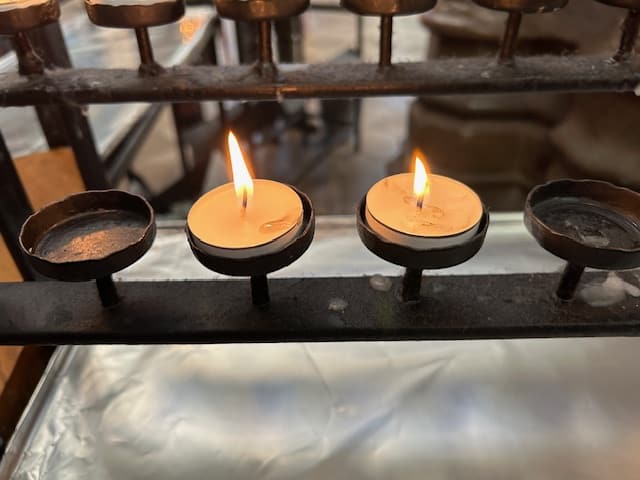
The flow of images and ideas slowed to a trickle, then to a drip – and I feared they would dry up completely. When this happened to me recently, I blamed the usual suspects: not enough sleep, too much work, plenty of distractions. But even when I slept more and finished client projects to ease the pressure, I still struggled with my creative writing.
Over the past 40 years – from being a journalist to becoming a nonfiction author, a creative writer, and now a mystery novelist – I’ve endured a few episodes of the dreaded writer’s block when it feels impossible to produce anything new.
Writer’s Block or Writer’s Bump?
Fortunately, this time I could still crank out the words, but my writing felt stale and lifeless. Rather than full-blown writer’s block, I chose to call this “writer’s bump” – like a speed bump that slows progress and makes for a rocky ride. To get back into a smooth flow, I needed to reset and refresh.
Many practices can help us shift our mindset: walking, journaling, yoga – just to name a few. My sister, Jeannie, swears by what she calls “escaping to my garden – to lose myself and all track of time.” I’ve even reaped therapeutic benefits from mundane, repetitive activities like washing dishes (turns out, it’s a thing – the “zen of dishwashing”).
Whatever activity we choose, it’s only the tactic – our means to a desired end. Far more important is what that “doing” does to us. Here are three of my favorite refreshers:
Light a Candle
A few years ago, I found myself stockpiled with candles – several fat pillars and dozens of tiny votives; some were scented floral or woodsy, others had no smell at all. Most had been given to me as gifts, which I tucked away for some future occasion. Finally, it occurred to me that instead of gathering dust, they should be giving light!
What started out as consuming excess wick and wax became a kind of ritual. There is nothing quite so mesmerizing as tongues of flame – the same sensation we feel in front of a fireplace or around a campfire (and without having to split the kindling or deal with the embers and ashes).
Candles are everywhere to the point of being cliché. In spiritual and religious traditions of all types, they are used for prayer and meditation. On a recent trip to England and Scotland, I lit candles in every cathedral we visited, sending thoughts and love for people back home. And in restaurants at night, there were nearly identical votives creating ambience.

The breakthrough for me, though, is lighting candles just for myself. For example, a small trio – red, deep purple, and lavender – sits on my desk. When my writing isn’t flowing because of some writers’ bump, striking a match and touching it to a wick draws my focus inward. As my mind relaxes, ideas begin to surface.
Walk a Labyrinth
A narrow path winds forward, then loops back, continuously circling in unexpected directions. Although the end is in sight the whole time, the more I walk the farther I seem to be moving from the destination.
This is a labyrinth, with coiling pathways that appeal to my contemplative, wannabe-mystic side. Some are large and elaborate, such as the one I stumbled across in Scottsdale, Arizona, where I went into a retreat center in hopes of getting directions back to my hotel. (It went something like this: “Hi, I’m lost. Oh, you have a labyrinth. Can I walk it?”) Others are small and modest, like a tightly turning etch on the ground made by a local Girl Scout troop at a park near where I used to live.
Labyrinths are everywhere – and there are locators to help find them. Unlike a maze, which is meant to confuse, a labyrinth reveals its entire path. The only question is how many twists and turns you’ll encounter from beginning to end. If that’s not an imitation of a writer’s path, I don’t know what is.
Walking a labyrinth reminds us that progress is rarely linear. No matter how precisely we set our goals and plot our course, detours and even setbacks are inevitable. But they don’t have to derail us. Instead, they can turn us in a new direction, such as switching genres (which I did, from nonfiction to fiction) or rewriting something that, frankly, just isn’t working.
Wander in Silence
I used to call myself the “queen of multi-tasking.” Why do one thing when I could do two or three at the same time? (Yeah, I was that person.) My daily run was a perfect pairing of exercise and making phone calls or enjoying the latest release on Audible.
When my recent case of writer’s bump hit, though, I knew I had to stop. That steady stream of conversations, podcasts, and audiobooks was overwhelming my brain. Suddenly, I wanted silence.
[See my video on Silence: The Secret Partner to Abundant Creativity]
A hiking trail near my home leads into the woods. Within a mile, I can shed most of the noise of civilization and concentrate only on natural sounds – birds calling, branches rustling, tall grasses rippling. This white noise au naturel not only soothes, but also immerses me in the details of my surroundings—like four different shades of spring green or how low clouds settle on the foothills. The more I notice, the more images and descriptions I collect for my mental writing file from which new ideas are born, such as my recent short story, Old Growth.
When the going gets tough, pushing through may not serve us as well as pausing. Whether it’s a flickering candle, a looping labyrinth, the silent woods, or any other respite, we can use them to reset and refresh, then resume our writing.
Let’s Have a Conversation:
Have you ever faced writer’s block – and, if so, what did you do to cope? What activities allow you to pause and unplug – to recharge your creative battery? If you could engage in one restorative practice every week, what would it be?





